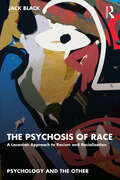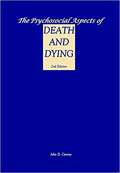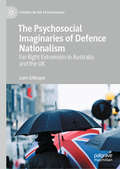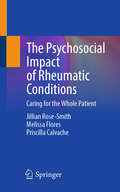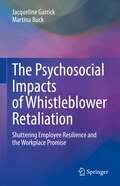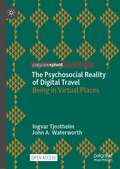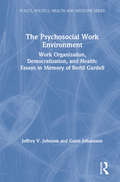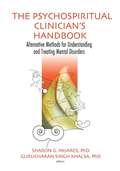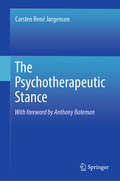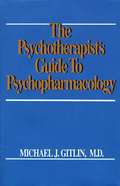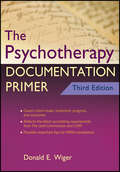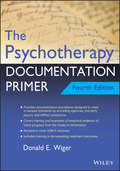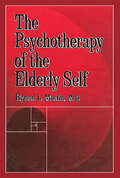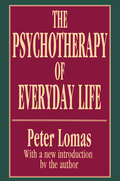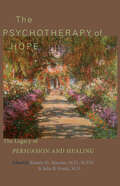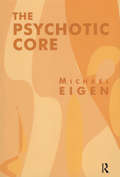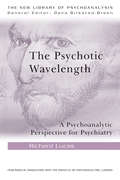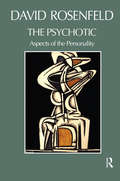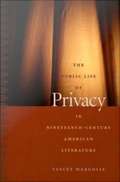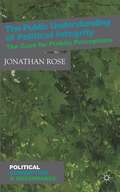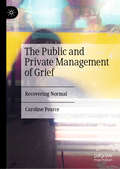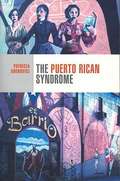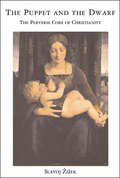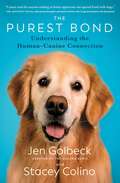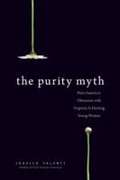- Table View
- List View
The Psychosis of Race: A Lacanian Approach to Racism and Racialization (Psychology and the Other)
by Jack BlackThe Psychosis of Race offers a unique and detailed account of the psychoanalytic significance of race, and the ongoing impact of racism in contemporary society. Moving beyond the well-trodden assertion that race is a social construction, and working against demands that simply call for more representational equality, The Psychosis of Race explores how the delusions, anxieties, and paranoia that frame our race relations can afford new insights into how we see, think, and understand race’s pervasive appeal. With examples drawn from politics and popular culture—such as Candyman, Get Out, and the music of Kendrick Lamar—critical attention is given to introducing, as well as explicating on, several key concepts from Lacanian psychoanalysis and the study of psychosis, including foreclosure, the phallus, Name-of-the-Father, sinthome, and the objet petit a. By elaborating a cultural mode to psychosis and its understanding, an original and critical exposition of the effects of racialization, as well as our ability to discern the very limits of our capacity to think through, or even beyond, the idea of race, is provided. The Psychosis of Race speaks to an emerging area in the study of psychoanalysis and race, and will appeal to scholars and academics across the fields of psychology, sociology, cultural studies, media studies, and the arts and humanities.
The Psychosocial Aspects of Death and Dying
by John D. Canine“Psychosocial Aspect of Death and Dying, which was originally three years in the making, is a unique text. Written specifically for university-level students studying funeral service, it presents in one volume materials from a variety of sources. Dr. John Canine has successfully complied this material into a logical sequence to enable the reader to better understand death from it psychological and sociological perspectives and, with this knowledge, to become better prepared to confront the issues in his or her own life. This text presents the funeral service practitioner with a compact brief on these issues, and as a result offers a ready reference tool.”
The Psychosocial Imaginaries of Defence Nationalism: Far-Right Extremism in Australia and the UK (Studies in the Psychosocial)
by Liam GillespieThe Psychosocial Imaginaries of Defence Nationalism interrogates the emergence of far-right nationalist 'defence leagues' in Australia and the UK. Throughout the book, Liam Gillespie refers to these groups as defence nationalists: that is, as nationalists who imagine themselves as defenders of the nation and therefore national subjects par excellence. Drawing on original research, psychoanalytic and psychosocial theory—and particularly the work of Jacques Lacan—the author explores the narratives, imaginaries and subjectivities that sustain these groups, as well as the narratives, imaginaries and subjectivities these groups sustain. He argues that unlike other nationalist groups, defence nationalists are not primarily concerned with realising their avowed political projects. Instead, they are concerned with constructing and then enjoying themselves as the nation's self-ordained defenders. This means that which threatens the nation can paradoxically have a fortifying effect upon defence nationalists, legitimising and securing both the way they see themselves, and the position they see themselves occupying with/in the nation.The Psychosocial Imaginaries of Defence Nationalism will be of interest to anyone concerned with critical theorisations of contemporary nationalism, as well as with the application of psychoanalytic and psychosocial theory to social, cultural and political analysis.
The Psychosocial Impact of Rheumatic Conditions: Caring for the Whole Patient
by Melissa Flores Jillian Rose-Smith Priscilla CalvacheThis book focuses on a holistic approach to providing care to patients with rheumatic illnesses that goes beyond the biomedical approach to include the psycho-social and cultural needs of patients. A diagnosis of a chronic rheumatic illness can dramatically affect all aspects of a person&’s life. These life-altering conditions are characterized by physical pain and inflammation that may reduce or impair functioning of one or more parts of the musculoskeletal system and in some cases impact other organs throughout the body. Often accompanying these physical manifestations of the rheumatic illness are the psychological and social aspects that affect one&’s overall health and quality of life. Due to the chronicity of many rheumatic illnesses, managing and coping with the illness is often an ever-evolving process that can span throughout the developmental spectrum or lifespan of the patient experience. A strictly biomedical approach to the treatment of rheumatic illnesses often fails to address these key aspects of the patients' overall well-being. A more comprehensive approach, inclusive of the bio-psycho-social-cultural lens, with the patient&’s voice at its core, is needed to inform and ultimately deliver quality patient care and achieve optimal health outcomes. This book serves as s a tool for the entire interdisciplinary rheumatology health care team. This comprehensive approach is framed within the context of well-documented health disparities in rheumatology with a focus on psycho, social, emotional and environmental aspects of health that contribute to patient quality of life. It explores the needs of special populations and provide opportunities for clinicians to consider how to treat diverse populations in a more inclusive way. At the center of this book is the patient&’s voice utilizing patient stories to provide the reader with real life examples that reflect the life cycle of rheumatology patients and the impact of key interventions or lack thereof that can impact the patient experience. Lastly, offers practical, evidence-based strategies for members of the rheumatology health care team. These tools can be integrated in their assessment and treatment plans for patients and their loved ones. This holistic approach can help to foster effective communication, build trust, enhance partnerships and amplify the patient voice to optimize health outcomes and enhance overall well-being.
The Psychosocial Impacts of Whistleblower Retaliation: Shattering Employee Resilience and the Workplace Promise
by Jacqueline Garrick Martina BuckThis book analyzes the harms related to whistleblower retaliation, its psychosocial impacts on employees, and the institutional dysfunction it creates and perpetuates. Stigma and biases against whistleblowers interfere with their ability to make protected disclosures when harm to others is at stake. Retaliatory toxic tactics create an atmosphere and corporate culture that embodies fear and encourages bystander behavior. In this book, the authors explore psychosocial impacts across domains that include financial, legal, social, physical, and emotional well-being. Ten of the 14 chapters specifically examine the toxic tactics of retaliation: gaslighting, mobbing, marginalizing, shunning, devaluing, double-binding, career blocking, counter-accusing, bullying, and doxxing. These toxic tactics are the building blocks of workplace traumatic stress (WTS) and can lead to posttraumatic stress disorder (PTSD), depression, substance abuse, and suicide. WTS is a term that differentiates between workplace violence or job stress, which can be components of WTS but do not fully describe the systemic hostile work environment that targets an employee. Understanding WTS and how it disrupts identity, causes moral injury, and shatters world views are important aspects for clinicians treating clients who are victims of this kind of hostile work environment. The Psychosocial Impacts of Whistleblower Retaliation is a useful resource offering a new way for social workers, mental health providers, advocates, and other support services professionals and practitioners to assist whistleblowers. It helps clinicians understand how to view patients suffering from whistleblower retaliation and gives them a lexicon for forensic evaluations. Lawyers, especially those specializing in employment, labor, and Qui Tam cases, also could benefit from having a means to describe the psychosocial impacts of retaliation and WTS on their clients when filing for compensatory damages for pain and suffering during judicial proceedings. Finally, the book could appeal to employees and managers, human resources professionals, victim rights advocates, elected officials, media personnel, and other professionals who are interested in learning more about whistleblower retaliation and its psychosocial and cultural implications.
The Psychosocial Reality of Digital Travel: Being in Virtual Places
by Ingvar Tjostheim John A. WaterworthThis open access book takes a fresh look at the nature of the digital travel experience, at a time when more and more people are engaged in online social interaction, games, and other virtual experiences essentially involving online visits to other places. It examines whether these experiences can seem real to the virtual traveller and, if so, under what conditions and on what grounds. The book unpacks philosophical theories relevant to the feeling of being somewhere, emphasising the importance of perception and being-in-the-world. Notions of place are outlined, based on work in tourism studies, human geography, and other applied social fields, with an aim to investigate how and when different experiences of place arise for the traveller and how these relate to telepresence – the sense of being there in another place through digital media. Findings from recent empirical studies of digital travel are presented, including a survey from which the characteristics of “digital travellers” are identified. A review of selected interactive design trends and possibilities leads to the conclusion, which draws these strands together and looks to the future of this topical and expanding field.
The Psychosocial Work Environment: Work Organization, Democratization, and Health : Essays in Memory of Bertil Gardell (Policy, Politics, Health and Medicine Series)
by Jeffrey V. Johnson Bertil Gardell Gunn JohannsonDedicated to the late Bertil Gardell, a Swedish Social Scientist, this text comprises of 18 essays that shares a common vision - the impact of work on the interconnected processes of stress and disease.
The Psychospiritual Clinician's Handbook: Alternative Methods for Understanding and Treating Mental Disorders
by Gurucharan Singh Khalsa Sharon G MijaresLearn to treat a variety of diagnostic disorders through various psychospiritual treatment models!Increasing numbers of people are moving beyond psychological therapy to seek alternative spiritual perspectives to medical and mental health care such as yoga and meditation. The Psychospiritual Clinician’s Handbook: Alternative Methods for Understanding and Treating Mental Disorders provides the latest theoretical perspectives and practical applications by recognized experts in positive and integrative psychotherapy. Leading clinicians examine and re-examine their therapeutic worldviews and attitudes to focus on the right problems to solve—for the whole person.This essential Handbook is a window on the quiet revolution now sweeping the field of psychology, that of locating the whole human being in the center of the therapeutic process. The Psychospiritual Clinician’s Handbook: Alternative Methods for Understanding and Treating Mental Disorders helps you effectively treat the whole person by providing a practical introduction to some of the worldviews and most effective practices like yoga, meditation, and humanological therapy used by psychospiritually oriented therapists. Helpful illustrations of body positions used in yoga and meditation plus photographs, tables, figures, and detailed case studies illustrate the process.The Psychospiritual Clinician’s Handbook: Alternative Methods for Understanding and Treating Mental Disorders will show you: the importance of a therapist’s worldview for effective therapeutic outcome new perspectives on alternative treatments for depression, anxiety, eating disorders, OCD, PTSD, ADHD, Alzheimer’s disease, and sexual dysfunction how yoga and mindfulness meditation can be used in psychotherapy the use and integration of meditation therapies in emergency situations the therapeutic integration of other alternative treatments, such as Kundalini yoga each contributor’s case studies as illustration of effective treatmentThe Psychospiritual Clinician’s Handbook: Alternative Methods for Understanding and Treating Mental Disorders is an invaluable resource for those interested in treating patients with a therapeutic process that is effective, adaptable, and wholly transformational.
The Psychotherapeutic Stance
by Carsten René JørgensenThis book provides a thorough critique of the dominating medical understanding of psychotherapy and argues for a dynamic relational understanding of psychotherapy, deeply founded in the most important results from empirical psychotherapy research. In the first part, the book critically examines the traditional focus on technical factors in psychotherapy based on available empirical research on the subject. It asks questions about whether specific techniques cure specific diagnoses or therapists and therapeutic relationships that cure persons. Part II of the book argues that the currently dominating medical understanding of psychotherapy must be challenged by a better understanding of psychopathology and psychotherapy that contextualizes the relationship between therapist and the patient. Overall, this book provides a new approach to some of the most important questions in psychotherapy and discusses what it means to think and work psychotherapeutically. The book is highly relevant for professionals in clinical/psychotherapy training and for advanced courses in psychotherapy, including courses on mentalization-based therapy, psychoanalytic psychotherapy and eclectic psychotherapy.
The Psychotherapist’s Guide to Psychopharmacology
by Michael J. GitlinGitlin (psychiatry, UCLA) provides a guide to medicines used for treating mental and emotional disorders, designed to familiarize mental health professionals who do not prescribe medicine with the latest medical treatment options. He describes the type of treatment used for numerous disorders, explaining in detail how each medication works and its effects.
The Psychotherapy Documentation Primer
by Donald E. WigerEverything you need to know to record client intake, treatment, and progress-incorporating the latest managed care, accrediting agency, and government regulations Paperwork and record keeping are day-to-day realities in your mental health practice. Records must be kept for managed care reimbursement; for accreditation agencies; for protection in the event of lawsuits; to meet federal HIPAA regulations; and to help streamline patient care in larger group practices, inpatient facilities, and hospitals. The standard professionals and students have turned to for quick and easy, yet comprehensive, guidance to writing a wide range of mental health documents, the Third Edition of The Psychotherapy Documentation Primer continues to reflect HIPAA and accreditation agency requirements as well as offer an abundance of examples. The new edition features: Revised examples of a wider range of psychological concerns New chapters on documentation ethics and the art and science of psychological assessment and psychotherapy Study questions and answers at the end of each chapter Greatly expanded, The Psychotherapy Documentation Primer, Third Edition continues to be the benchmark record-keeping reference for working professionals, reflecting the latest in documentation and reporting requirements.
The Psychotherapy Documentation Primer (The\psychotherapy Treatment Planners (si45) Ser. #Vol. 16)
by Donald E. WigerProvides documentation procedures designed to meet or exceed standards by accreding agencies, 3rd party payors, and HIPAA compliance Covers training and examples of empirical evidence of client progress from the intake to termination Revised to cover DSM-5 revisions Includes training in documenting treatment outcomes Everything you need to know to record client intake, treatment, and progress—incorporating the latest managed care, accrediting agency, and government regulations Paperwork and record keeping are day-to-day realities in your mental health practice. Records must be kept for managed care reimbursement; for accreditation agencies; for protection in the event of lawsuits; to meet federal HIPAA regulations; and to help streamline patient care in larger group practices, inpatient facilities, and hospitals. The standard professionals and students have turned to for quick and easy, yet comprehensive, guidance to writing a wide range of mental health documents, the Fourth Edition of The Psychotherapy Documentation Primer continues to reflect HIPAA and accreditation agency requirements as well as offer an abundance of examples. Fully updated to include diagnostic criteria of the DSM-5, The Psychotherapy Documentation Primer, 4th Edition is designed to teach documental skills for the course of psychotherapy from the initial interview to the discharge. The documentation principles discussed in the text satisfy the often-rigid requirements of third-party insurance companies, regulating agencies, mental health licensing boards, and federal HIPAA regulations. More importantly, it provides students and professionals with the empirical and succinct documentation techniques and skills that will allow them to provide clear evidence of the effects of mental health treatment while also reducing the amount of their time spent on paperwork.
The Psychotherapy Of The Elderly Self
by Hyman L. MuslinPeople grow old. We are terrified by the fact. And this fear has translated into a pervasive neglect of the elderly across all spheres of living. Now Dr. Hyman Muslin steps forward to challenge the mental health field to reevaluate its perspective on this powerful human resource. The book is written in the effort to dispel some of the myths of aging; to highlight old age as a natural developmental phase and to delineate an effective model of observation, diagnosis and therapy for working with the elderly. Ultimately, Dr. Muslin's message is one of hope - for older individuals currently in need of psychological help and for the elderly self who awaits us all.
The Psychotherapy of Everyday Life (History Of Ideas Ser.)
by Peter LomasThe place of the psychotherapist within the hierarchy of the medical profession and his status in the public opinion are ambiguous: many myths and ill-informed fears cloud the practice of psychotherapy not the least of which is the thorny issue of doctor-patient relationships. In this finely etched book, Peter Lomas puts the case for a personal psychotherapeutic approach based on his work with patients over many years.The Psychotherapy of Everyday Life argues that the response to a person who comes for help should be an intuitive one, not hidebound by confusing technical theory. Psychotherapy is best understood as the application of ordinary interpersonal competence within an unusual setting, and formulations about its nature should take this point into account as their starting point.In his brilliant new introduction, the author juxtaposes the clinical neutrality of Sigmund Freud to the Saridor Ferenczi position, which entails a sense of the rights of and respect for the patient. Lomas holds that Freud initiated the setting but brought to bear upon it an unnecessary and inappropriate theoretical superstructure that now stands between therapist and patient. It is not ideology but everyday judgment that should be the touchstone of treatment. Rigid professional distance can blind the analyst to the actual needs of real people.
The Psychotherapy of Hope: The Legacy of Persuasion and Healing
by Renato D. Alarcón and Julia B. FrankDirectly inspired by the work of Jerome D. Frank and his field-defining book Persuasion and Healing, this volume of essays by distinguished contemporary scholars broadly assesses the current state of research and practice in psychotherapy. Editors Renato D. Alarcón, a former student of Frank's, and Julia B. Frank, Jerome Frank's daughter and coauthor, bring diverse perspectives to the volume. Each chapter, based on one of the themes of Frank’s classic book, offers honest critique and fearless criticism of psychotherapy as it has evolved in the twenty-first century. Contributors update classical psychotherapeutic concepts such as demoralization, hope, meaning, rhetoric, and cultural variation and add new insight into how the neuroscience revolution affects our understanding of mental organization and psychotherapy. As Frank did in his own time, these authors challenge the claims made for the specificity or superiority of cognitive behavioral, psychodynamic, and other varieties of psychotherapy, providing a candid assessment of the value and limitations of many competing approaches to diagnosis and treatment. They also focus attention on psychotherapies for special populations, including children, people with serious medical illness, and those from culturally and religiously diverse backgrounds. Like Persuasion and Healing, this volume advocates not for any particular approach but for psychotherapy more generally grounded in principles of evolutionary biology, culture, narrative, and behavior change. It provides researchers, theorists, and practitioners of every kind of training with a genuinely phenomenological approach to a wide range of psychiatric issues. Echoing Frank's voice, in particular his emphasis on the commonalities of suffering and the therapeutic power of hope, The Psychotherapy of Hope offers scholarly wisdom and practical advice on how to understand psychotherapy—and apply its principles to the greatest benefit of patients.
The Psychotic Core
by Michael EigenThis book examines the key ordering—disordering processes of the psychotic self. It draws on Sigmund Freud, Jung, object relation and selfpsychologies, and, particularly, the work of Winnicott, Bion, and Elkin.
The Psychotic Wavelength: A Psychoanalytic Perspective for Psychiatry (The New Library of Psychoanalysis)
by Richard LucasThe Psychotic Wavelength provides a psychoanalytical framework for clinicians to use in everyday general psychiatric practice and discusses how psychoanalytic ideas can be of great value when used in the treatment of seriously disturbed and disturbing psychiatric patients with psychoses, including both schizophrenia and the affective disorders. In this book Richard Lucas suggests that when clinicians are faced with psychotic patients, the primary concern should be to make sense of what is happening during their breakdown. He refers to this as tuning into the psychotic wavelength, a process that allows clinicians to distinguish between, and appropriately address, the psychotic and non-psychotic parts of the personality. He argues that if clinicians can find and identify the psychotic wavelength, they can more effectively help the patient to come to terms with the realities of living with a psychotic disorder. Divided into five parts and illustrated throughout with illuminating clinical vignettes, case examples and theoretical and clinical discussions, this book covers: the case for a psychoanalytical perspective on psychosis a historical overview of psychoanalytical theories for psychosis clinical evidence supporting the concept of a psychotic wavelength the psychotic wavelength in affective disorders implications for management and education. The Psychotic Wavelength is an essential resource for anyone working with disturbed psychiatric patients. It will be of particular interest to junior psychiatrists and nursing staff and will be invaluable in helping to maintain treatment aims and staff morale. It will also be useful for more experienced psychiatrists and psychoanalysts.
The Psychotic: Aspects of the Personality
by David RosenfeldThe Psychotic: Aspects of the Personality presents the results of the author's many years of experience as an analyst working with deeply disturbed or psychotic patients, and demonstrates how the deeply resulting clinical and theoretical formulations may additionally be applied to less disturbed patients. Dealing with the theory and clinical treatment of the psychotic aspects of the personality, includes a review of the literature and a rich array of clinical material to illustrate the author's technical approach. A chapter devoted to the survivors of concentration camps shows how the concept of encapsulated autistic nuclei leads to new diagnostic and technical procedures, while a further paper discusses the psychotic difficulties attending heart-transplant surgery. Further essays illuminate the importance of the accurate detection and the use of the countertransference and the significance of the supervisor's supportive role in severe cases.
The Public Life of Privacy in Nineteenth-Century American Literature
by Stacey MargolisStacey Margolis rethinks a key chapter in American literary history, challenging the idea that nineteenth-century American culture was dominated by an ideology of privacy that defined subjects in terms of their intentions and desires. She reveals how writers from Nathaniel Hawthorne to Henry James depicted a world in which characters could only be understood--and, more importantly, could only understand themselves--through their public actions. She argues that the social issues that nineteenth-century novelists analyzed--including race, sexuality, the market, and the law--formed integral parts of a broader cultural shift toward understanding individuals not according to their feelings, desires, or intentions, but rather in light of the various inevitable traces they left on the world. Margolis provides readings of fiction by Hawthorne and James as well as Susan Warner, Mark Twain, Charles Chesnutt, and Pauline Hopkins. In these writers' works, she traces a distinctive novelistic tradition that viewed social developments--such as changes in political partisanship and childhood education and the rise of new politico-legal forms like negligence law--as means for understanding how individuals were shaped by their interactions with society. The Public Life of Privacy in Nineteenth-Century American Literature adds a new level of complexity to understandings of nineteenth-century American culture by illuminating a literary tradition full of accidents, mistakes, and unintended consequences--one in which feelings and desires were often overshadowed by all that was external to the self.
The Public Understanding of Political Integrity
by Jonathan RoseThrough detailed analyses of major and newly available datasets, this study examines the utility of a public probity-focused approach to understanding citizen disaffection with politicians. It shows that perceptions of public probity are coherent, substantively meaningful, responsive, and, most importantly, that they do matter.
The Public and Private Management of Grief: Recovering Normal
by Caroline PearceThrough a critical analysis of theory, policy and practice, The Public and Private Management of Grief looks at how 'recovery' is the prevailing discourse that measures and frames how people grieve, and considers what happens when people 'fail' to recover. Pearce draws on in-depth interviews with bereaved people and a range of bereavement professionals, to contemplate how ‘failures’ to recover are socially perceived and acted upon. Grounded in Foucauldian theory, this book problematises the notion of recovery, and instead argues for the acknowledgment of the experience of ‘non-recovery,’ highlighting how recovery is a socially and historically constructed notion linked to the individualised vision of health and happiness promoted by neo-liberal governmentality. This book will be of interest to students and scholars across sociology, anthropology, social work and psychology with a focus on death, dying and bereavement, grief studies, health and social care, as well as counsellors, clinical psychologists and social workers.
The Puerto Rican Syndrome
by Patricia GheroviciPhiladelphia-based Lacanian psychoanalyst Gherovici investigates the cultural, political, and psychological nexus of the Puerto Rican community in relation to mainstream US culture. She begins during the McCarthyite 1950s, when psychoanalysis was rejecting the notion of hysteria and Puerto Rican soldiers began suffering its symptoms. Annotation ©2004 Book News, Inc. , Portland, OR (booknews. com)
The Puppet and the Dwarf: The Perverse Core of Christianity (Short Circuits)
by Slavoj ZizekOne of our most daring intellectuals offers a Lacanian interpretation of religion, finding that early Christianity was the first revolutionary collective. Slavoj Žižek has been called "an academic rock star" and "the wild man of theory"; his writing mixes astonishing erudition and references to pop culture in order to dissect current intellectual pieties. In The Puppet and the Dwarf he offers a close reading of today's religious constellation from the viewpoint of Lacanian psychoanalysis. He critically confronts both predominant versions of today's spirituality—New Age gnosticism and deconstructionist-Levinasian Judaism—and then tries to redeem the "materialist" kernel of Christianity. His reading of Christianity is explicitly political, discerning in the Pauline community of believers the first version of a revolutionary collective. Since today even advocates of Enlightenment like Jurgen Habermas acknowledge that a religious vision is needed to ground our ethical and political stance in a "postsecular" age, this book—with a stance that is clearly materialist and at the same time indebted to the core of the Christian legacy—is certain to stir controversy.
The Purest Bond: Understanding the Human–Canine Connection
by Stacey Colino Jen GolbeckA feel-good, comprehensive exploration of the profound bond between humans and dogs from Jen Golbeck, the &“internet&’s dog mom&” behind the massive social media platform The Golden Ratio, and Stacey Colino, an award-winning science writer.Dogs have been considered people&’s best friend for thousands of years, but never has the relationship between humans and their canine companions been as vitally important as it is today. With all of the seismic shifts in today&’s world, rates of anxiety and depression have been skyrocketing, and people have been turning to their dogs for solace and stability. Amidst these dire realities, something wonderful has taken shape. In the United States alone, dog adoptions doubled during the COVID-19 pandemic. As people have brought furry friends into their lives for the first time or seized this opportunity to deepen the connections they already have, they are looking to understand how owning a dog can change their lives. Now, The Purest Bond explores the benefits our dogs can have on our physical, emotional, cognitive, and social well-being, often without our realizing it. Weaving together groundbreaking research and touching real-life stories, The Purest Bond explores not just the social benefits of owning a dog but the science of how dogs improve our emotional and physical health, mental acuity, and our ability to focus and absorb information. Most importantly, they remind us of what&’s right in the world—love, trust, affection, playtime, fresh air, and sunshine—even when so much feels wrong.
The Purity Myth: How America's Obsession with Virginity Is Hurting Young Women
by Jessica ValentiThe United States is obsessed with virginity -- from the media to schools to government agencies. In The Purity Myth, Jessica Valenti argues that the country's intense focus on chastity is damaging to young women. Through in-depth cultural and social analysis, Valenti reveals that powerful messaging on both extremes -- ranging from abstinence-only curriculum to "Girls Gone Wild" infomercials -- place a young woman's worth entirely on her sexuality. Morals are therefore linked purely to sexual behavior, rather than values like honesty, kindness, and altruism. Valenti sheds light on the value -- and hypocrisy -- around the notion that girls remain virgins until they're married by putting into context the historical question of purity, modern abstinence-only education, pornography, and public punishments for those who dare to have sex. The Purity Myth presents a revolutionary argument that girls and women are overly valued for their sexuality, as well as solutions for a future without a damaging emphasis on virginity.
